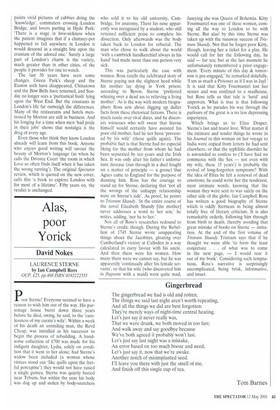The puzzle of eternal charm
Mark Mason
IN SEARCH OF LONDON by H. V. Morton Methuen, £9.99, pp. 440, ISBN 0413184706 Most people take on holiday with them both a guide book and a good read. You could do far worse this year than to spend your time in London, allowing this book to fulfil both functions.
In Search of London, first published in 1951, was the late travel writer H. V. Morton's attempt to both chronicle London's history and solve the puzzle of its continuing charm. As he wanders the city, alternately imparting knowledge and querying his observations, a theme develops of that charm and that history being inextricably linked.
The Thames, for instance:
I saw its waters below me, dark, oily and swift, and I began to think of its 19 centuries of history, a long time for men to have lived in the same place, striving, loving, hating, building and pulling down, failing and succeeding ...
Morton also sees London as a city of experts:
Among them are those who, having been in the fish trade all their lives, know everything that is to be known about fish These experts are every bit as learned in their own way as the art connoisseurs who, in the salerooms of St James's, can tell you what is genuine and what is not.
Morton (who, like many who love London most keenly, was not originally from the city) has a talent for enlivening his history lessons with the most intriguing of facts. The Public Record Office cat, we learn, is officially a civil servant. Embedded in the north side of Trafalgar Square, well hidden by tourist-laden benches, are strips of brass which act as the official imperial measurements from one inch to 100 feet CI always look, in the hope of finding some anxious draper making sure that his yardstick is in order.) The chimes of Big Ben are singing out, 'So hour by hour, Be Thou my guide, That by Thy power, No step may slide.'
But just as important to Morton as the historical is the everyday. 'You look at this street, and wonder why people go to the Zoo. Human beings are so much more interesting to watch than animals, and so much more difficult to understand.' He paints vivid pictures of cabbies doing the 'knowledge', commuters crossing London Bridge, and lovers parting in Hyde Park: 'There is a stage in love-sickness when the patient imagines that if a chimney-pot happened to fall anywhere in London it would descend in a straight line upon the cranium of the adored one.' Surely a large part of London's charm is the variety, much greater than in other cities, of the people it provides for one to watch.
The last 50 years have seen some changes. Green Park's sheep and the Euston arch have disappeared, Chinatown and the Bow Bells have returned, and Sunday no longer sees a 'puritanical hush' lying upon the West End. But the constants in London's life far outweigh the differences. Many of the restaurants and hotels mentioned by Morton are still in business. And his longing for a time when men 'had pride in their jobs' shows that nostalgia is the drug of every age.
Even those who think they know London already will learn from this book. Anyone who enjoys good writing will savour the beauty of Morton's language (as when he calls the Divorce Court 'the room in which Love so often finds itself when it has taken the wrong turning'). The original Spectator review, which is quoted on the new cover, calls this 'a book to explore London with for most of a lifetime'. Fifty years on, the verdict is unchanged.



































































 Previous page
Previous page